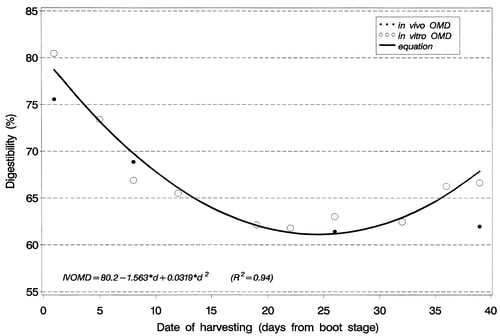DELAYING SMALL GRAIN HARVEST
Posted by Michael T. Harper, Ph. D. | Dairy Technical Specialist on May 1, 2020 8:00:00 AM
A strategy for increased forage yield during milk production constraints
Farmers across the country are having to reduce milk production due to reduced demand during this unprecedented time of the COVID-19 pandemic. While reducing ration energy density for some cows and drying others off early is a good strategy, a resulting challenge could be not having enough forage to fill the ration of more dry cows while concurrently increasing the fiber content of the post-peak lactating group. This article discusses delaying small grain harvest; a strategy for increased forage yield during milk production constraints.
A potential issue with this strategy is not having enough forage to fill the ration of more dry cows, to keep them from getting fat, while at the same time increasing the fiber content of the post-peak lactating group. Many studies have been conducted on the use of non-forage fiber sources such as wheat middlings, soy hulls, and cottonseed hulls among many others. Certainly, they can be a good source of neutral detergent fiber (NDF) to reduce the energy density of a diet. The digestibility of the NDF will vary from source to source and, in this circumstance of reducing milk production, less digestible may even be preferred. A couple challenges with these ingredients are that they are not produced on farm and they often increase DMI as they have a relatively high rate of passage with their small particle size. Straw and dry hay are good options, but again, they must typically be purchased from off the farm.
For farms that grow and harvest their own small grain cover crop silage, as is common in the Northeast and Midwest, there is potentially another option. Small grains, such as rye, wheat, and triticale, are often harvested early at a young and highly digestible stage of flag leaf or boot. With cows tuned for high production, harvesting for high NDF digestibility makes perfect sense. However, when lactating cows need to reduce their intake, rumens need to stay full, and forage/fiber tonnage is a primary goal, then letting the small grain mature past the boot stage may be a very good idea. Dry matter yield per acre can more than double from boot stage through milk stage to dough stage. Yes, digestibility does go down (see figure 1.) which in this situation would further help to reduce intakes, thereby reducing milk yield, and keep the rumen full to prevent displaced abomasum issues while helping to prevent excessive body condition.
 Figure 1. Relationship between date of harvesting and in vivo and in vitro OM digestibility of the wheat tested in the trial. Crovetto et al. 1998.
Figure 1. Relationship between date of harvesting and in vivo and in vitro OM digestibility of the wheat tested in the trial. Crovetto et al. 1998.
There are some possible challenges with letting small grains mature past the boot stage before ensiling:
- It can delay corn planting by a few weeks. This can decrease corn silage yield around 1 ton per week delay depending on growing degree days.
- It delays when the forage is available to be fed which is ideally a few weeks after harvest.
- The forage remains slowly digestible even when milk demand returns.
- Higher yield may require more work (wide swath mowing with tedding) to dry down, though this would somewhat be balanced by longer daylight and a drier starting material.
To mitigate some of these challenges, it may be advisable to delay the harvest of a portion of one’s acres and harvest the others at the normal maturity target. This would provide some forage sooner which would have good digestibility for when milk demand returns. It would also free up some acres to spread manure and plant corn for silage on time. As with other forages, the rate of fiber digestibility of the mature small grain should be analyzed to properly model the forage in a ration. Farmers should be discussing this option with their nutritionist and weighing the benefits.
Download the DELAYING SMALL GRAIN HARVEST article.
______________________________________
Crovetto, G. M., G. Galassi, L. Rapetti, A. Sandrucci, and A. Tamburini. 1998. Effect of the stage of maturity on the nutritive value of whole crop wheat silage. Livestock Production Science 55:21–32.
Cyriac, Joby, "Effects of Replacing Forage Fiber with non-Forage Fiber in Lactating Dairy Cow Diets" (2005). Electronic Theses and Dissertations. 1464. https://openprairie.sdstate.edu/etd/1464
Firkins, J. L. 1997. Effects of feeding nonforage fiber sources on site of fiber digestion. J. Dairy Sci 80:1426-1437.
Harper, M. T. 2018. The use of sorghum, oat, wheat, triticale, and pearl millet silages in lactating dairy cow diets. PhD Dissertation. Penn State.
Topics: ANIMAL NUTRITION
